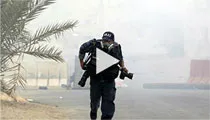The press began to blossom amid the political transition that followed the 2011 uprising that ended Muammar Qaddafi’s repressive rule. A burgeoning private media sector emerged with the launch of dozens of independent newspapers and other news outlets. Despite these notable improvements, journalists continued to face attacks, mostly from local militias and other armed groups that often detained people at whim. In February, a local militia in Tripoli seized two British journalists for almost a month. In July, two Libyan television journalists were kidnapped after covering the country’s first elections in decades. In May, the then-ruling National Transitional Council passed a law criminalizing the glorification of Qaddafi, but the Supreme Court struck down the measure as unconstitutional the next month, a historic move that reflected an emerging commitment to free speech.
Libya
» Notable improvements seen in press freedom after Qaddafi’s ouster.
» As government struggles to enforce the law, journalists face risk from militias.
The press began to blossom amid the political transition that followed the 2011 uprising that ended Muammar Qaddafi’s repressive rule. A burgeoning private media sector emerged with the launch of dozens of independent newspapers and other news outlets. Despite these notable improvements, journalists continued to face attacks, mostly from local militias and other armed groups that often detained people at whim. In February, a local militia in Tripoli seized two British journalists for almost a month. In July, two Libyan television journalists were kidnapped after covering the country’s first elections in decades. In May, the then-ruling National Transitional Council passed a law criminalizing the glorification of Qaddafi, but the Supreme Court struck down the measure as unconstitutional the next month, a historic move that reflected an emerging commitment to free speech.
UPDATE: The fourth tab has been corrected to reflect that there are 69 media outlets and to correctly represent the print, TV, and radio breakdown in the corresponding pie chart.
CPJ documented no work-related fatalities in Libya, a stark contrast to the previous year. In 2011, Libya was one of the most dangerous places in the world, with five journalists and one media worker killed during the eight-month uprising. Regionwide, fatalities soared in Syria but dropped in most other nations.
Bahrain |  |
Egypt |  |
Iran |  |
Iraq |  |
Israel and the Occupied Palestinian Territory |  |
Libya |  |
Syria |  |
Tunisia |  |
Yemen |  |
After widespread detentions and kidnappings in 2011, CPJ found a notable decrease in the number of unlawful seizures of journalists. Still, four journalists were held captive by armed groups in 2012. In one case, armed men kidnapped Abdelqadir Fassouk and Yusuf Badi, journalists for the private Tobacts TV station, while they were covering the country's first elections in decades. The two were held for nine days.

Two journalists from Misurata covering elections in Mizdah on July 7 were abducted and held in Bani Walid, Qaddafi's former stronghold. They were sent to Jadu after tribal negotiations on July 15, and returned to their hometown of Misurata on July 16.
Nicholas Davies-Jones and Gareth Montgomery-Johnson, British freelance journalists who often work for Iran's Press TV, were seized by a local militia on February 21 and held for more than three weeks. After being handed over to the Interior Ministry, the journalists eventually returned to London.
February 21: | Saraya Swehli militia seizes Davies-Jones and Montgomery-Johnson. |
February 23: | The Interior Ministry asks the militia to hand over the journalists but is initially rebuffed, according to Human Rights Watch. |
March 14: | Journalists handed over to the Interior Minister, according to news reports. |
March 19: | Journalists return to the U.K., according to news reports. |
Since the 2011 uprising, dozens of media outlets have sprung to life, including independent newspapers, television channels, and radio stations. Media in Cooperation and Transition, a German nonprofit that supports media and development projects, gathered a preliminary list of new print and broadcast media in January 2012.
| 43 | |
| 12 | Television |
| 14 | Radio |

